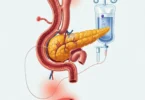The meningioma is generally a slow-growing, benign tumor emanating from the meninges of the central nervous system (CNS). Therefore, the meningioma is derived from the medical term “meninges”. Mostly the dura mater adherent bengin tumors of adulthood that arise from the lining cells of the pia mater.
Since Meningiomas are usually benign and grow slowly, sufferers develop only few symptoms often after years. The meningioma is therefore often an incidentally diagnose, which is noticeable in the context of other studies.
Under the microscope, different meningioma types can be distinguished. For the forecast tumor classification ( “grading”) is of importance:
- More than 85 out of 100 meningiomas belong to the WHO grade 1 classification of brain tumors, they grow very slowly and remain long without any symptoms. They are usually surgically removed completely.
- 10 of 100 meningiomas can be assign in the WHO grade II. A meningioma from this group is also atypical meningioma . You have an increased growth potential.
- Anaplastic meningiomas also belong to WHO grade II.
Causes Of Meningioma
The meningioma causes are not decrypted. A meningioma occurs when a particular cell type in the pia mater of brain moves, degenerate and overgrown. Why it happens, is still unclear.
Childrens who have already undergo a radiation therapy as in case of cancer, are at higher risk for development of particularly malignant brain tumors.
A loss of genetic material (chromosomes 22) seems remarkably often to communicate with meningiomas.
Symptoms of Meningioma
Symptoms of meningioma depend on location of tumor. For example the meningioma grows in the spinal canal , the complaints arise when the tumor compresses or squeezes individual nerve roots or the spinal cord. The range of symptoms extends from:
- Paresthesia (numbness)
- Mobility limitations of arms and legs
- Paralysis
In case of meningioma in the brain , especially in the cerebral hemispheres (hemisphere), symptoms are rare or mostly occurs in advanced stage of disease.
- Headache
- Epileptic seizures
- Blurred vision
- Emergence of the eyeball ( proptosis )
- Speech disorders
Sometimes the personality changes are also occur in the person. Especially in the elderly, this can confused with dementia (eg Alzheimer’s ) or depression.
If the meningioma is of the bony cranium, it can result in leading to an enhanced bone growth (hyperostosis) and thus a visible “bump” come.
Diagnosis of Meningioma
Play for meningioma diagnostics – As with all brain tumors the imaging techniques like computed tomography (CT) and magnetic resonance imaging (MRI) play the decisive role in meningoma diagnosis.
In rare cases, angiography is used. This study makes blood vessels visible. The treating physician can also use this method therapeutically to desolate blood vessels before surgery.
Doctor detects the well defined tumor on CT and MRI, which affect the meninges on a broad surface, this indicates a meningioma. This diagnosis is close if the mater is typically thickened in the edge region of the contact area. Something there are small calcifications in the tumor so-called Psammoma bodies. They occur in result of degradation processes in the tumor tissue.
Treatments of Meningioma
The meningioma therapy depends on tumor characteristics (eg size) and condition of the person concerned.
A meningioma, which is very small and does not cause symptoms requires no treatments, because of the benign character and the slow growth usually. It is enough to be seen with regular follow up examinations to verify how the meningioma developed.
In meningiomas of WHO grade I-II on basis of present symptoms, neurosurgeon peels out the tumor surgically. If possible, he should remove the entire tumor. The operation depends essentially on the following factors:
- General condition
- Complaints of those affected
- Tumor size
- Localization – ie where the tumor is located
- Growth behavior of the tumor
In the case of a highly perfused meningioma it can sometimes be useful, to close off blood vessels selectively prior to surgery ( “embolization”). Thus, greater blood loss during surgery can be avoided.
Meningioma WHO grade III and incompletely removed benign meningiomas (large residual tumor), require additional irradiation . Small tumors with a maximum diameter of three centimeters are suitable for a single irradiation, called radiosurgery with linear accelerator or “gamma knife”. This therapy might be recommended especially when the meningioma grows awkwardly. Radiosurgery is an alternative, in patients with an increased risk of surgery even with large recurrence (re-occurring after therapy meningioma).
A drug treatment – for example, with hormones or cytostatic agents ( chemotherapy ) – in meningiomas not belongs to standard therapy.
Preventions
General measures to prevent a meningioma are unknown. In general should be avoided unnecessary radiation (especially in children) and chemicals.
To generally support your body’s immune system and keep your overall risk of disease as low as possible, please note the following:
- Eat food low in fat.
- Do not use nicotine and alcohol.
- Do sports regulary.
For more information about cancer:







